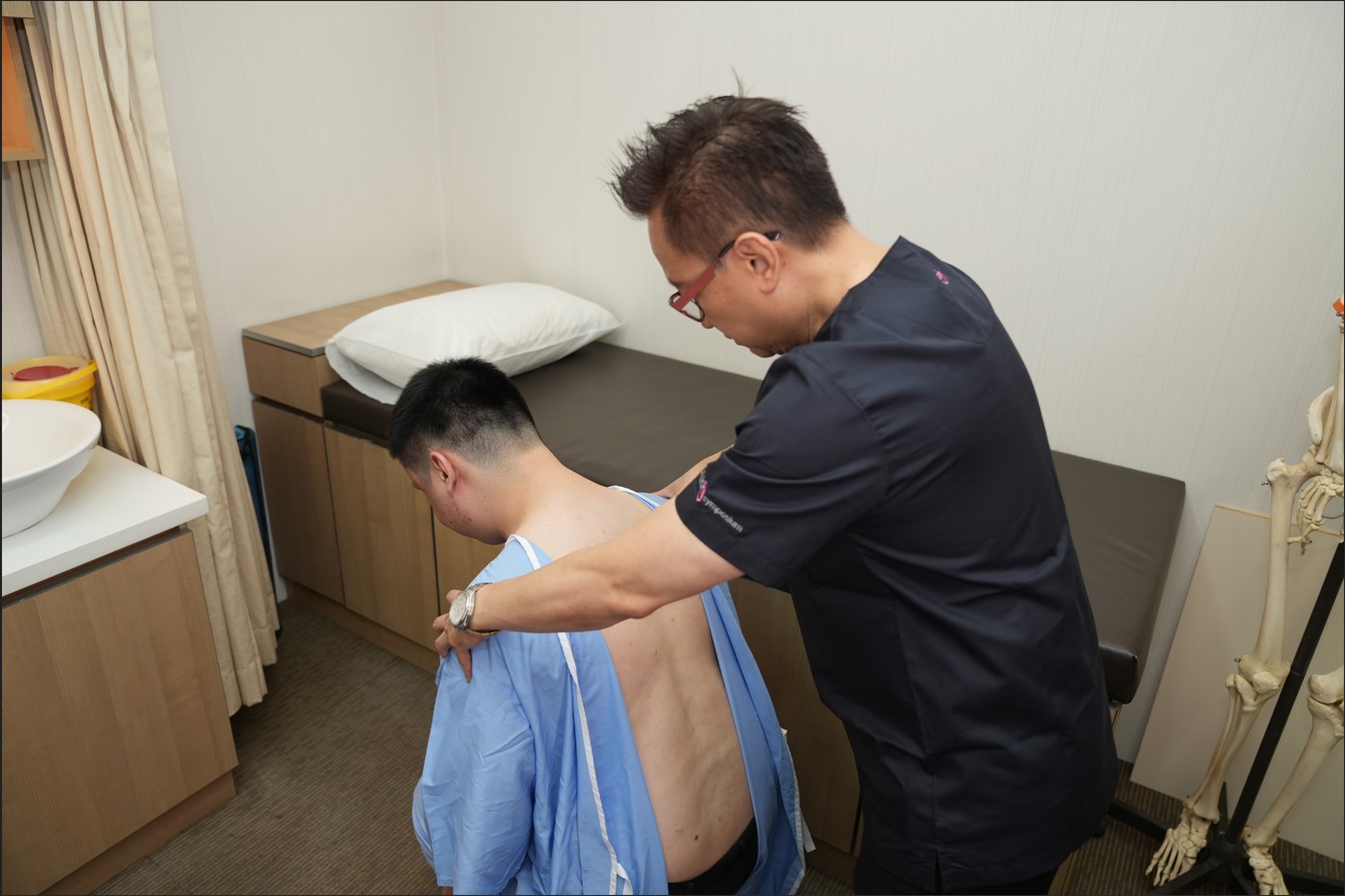What Causes Shoulder Pain?
Shoulder pain develops when the structures that allow smooth movement become irritated, strained, or injured. This often happens through everyday activities rather than major trauma.
Common causes include:
- Muscle or tendon strain: Repetitive lifting, overhead work, prolonged computer use, or sudden force can strain the muscles and tendons around the shoulder. This often causes aching pain, weakness, or discomfort when raising the arm.
- Rotator cuff irritation or injury: The rotator cuff helps stabilise and move the shoulder. When its tendons are overworked or injured, pain may appear during movement, at night, or when reaching overhead.
- Inflammation of soft tissues: Inflamed tendons (tendinitis) or bursae (bursitis) can cause pain, stiffness, and difficulty performing daily tasks. This is common among active individuals and those with prolonged poor posture.
- Tears of muscles or tendons: Partial or complete tears may occur suddenly after injury or gradually due to wear and tear. Even small tears can cause night pain, weakness, and reduced shoulder function.
- Joint wear or arthritis: Degeneration of the shoulder joint reduces smooth movement, leading to stiffness and pain that often worsens after rest or with activity.
- Instability or past dislocation: Previous shoulder dislocations or loose ligaments can cause a feeling of slipping, weakness, or pain during movement.
In many cases, shoulder pain comes from soft-tissue irritation rather than bone problems. Even when scans appear normal, inflammation or muscle imbalance can still significantly affect comfort and mobility.
Types of Shoulder Pain
Muscle- and Tendon-Related Shoulder Pain
This type of shoulder pain often develops from overuse, posture issues, or sudden strain.
- Shoulder Tendinitis: Irritation of a tendon that causes pain with movement and limits daily activities.
- Bursitis: Inflammation of the cushioning tissue in the shoulder, leading to pain when lifting or rotating the arm.
- Shoulder Impingement Syndrome: Occurs when tendons are compressed during movement, causing sharp pain when raising or lowering the arm.
- Muscle Strain or Spasm: Overstretching of muscles or ligaments can cause tightness, tenderness, and restricted movement.
Degenerative or Structural Shoulder Pain
This pain develops from wear, damage, or changes within the joint.
- Rotator Cuff Tears: Partial or full-thickness tears can cause weakness, night pain, and difficulty lifting the arm.
- Shoulder Arthritis: Gradual cartilage wear leads to stiffness, swelling, and pain that worsens with activity.
- Joint Degeneration: Age-related or repetitive stress changes can irritate surrounding tissues and restrict movement.
Injury-Related Shoulder Pain
Sudden force or trauma may damage the shoulder’s soft tissues.
- Shoulder Sprain: Ligament stretching or tearing after a fall or sudden movement, sometimes causing instability or bruising.
- Direct Impact Injuries: Falls or sports collisions can result in deeper soft-tissue injury and persistent pain.
Nerve-Related Shoulder Pain
Some shoulder pain is linked to nerve involvement.
- Shoulder Girdle Syndrome (Parsonage–Turner Syndrome): A rare condition involving nerve inflammation that begins with sudden severe pain, followed by weakness in the shoulder or arm.
Capsular Disorder
- Frozen Shoulder (Adhesive Capsulitis): Frozen shoulder develops gradually as the joint capsule thickens and tightens. Pain is often deep and aching, and movement becomes increasingly restricted — especially when reaching overhead or behind the back. Without early treatment, stiffness can persist for many months and significantly affect daily life.
Symptoms of Shoulder Pain
Shoulder pain can present differently from person to person. You may experience:
- Pain when reaching, lifting, dressing, or lying on the affected side
- Stiffness or reduced range of motion
- Weakness in the shoulder or arm
- Swelling, tenderness, or warmth after injury
- A feeling of instability or slipping
- Sleep disturbance due to night pain
If shoulder pain persists, worsens, or interferes with daily activities or sleep, assessment by a shoulder pain specialist can help prevent long-term stiffness and loss of function.
Treatment Options for Shoulder Pain in Singapore
Conservative Treatments
Many mild to moderate shoulder conditions improve with non-surgical care.
- Physical Therapy: Guided stretching, strengthening, and manual techniques help restore movement, support shoulder stability, and reduce pain.
- Rest, Ice, and Support: Short periods of rest, cold therapy, and temporary support may help reduce inflammation during flare-ups.
- Medication: Pain-relieving or anti-inflammatory medications may provide short-term symptom relief.
Minimally Invasive Procedures
When shoulder pain persists or structural problems are present, targeted minimally invasive treatments can relieve pain at its source — without the need for open surgery.
- Coreflex Injection: Reduces inflammation within irritated tendons or bursae, allowing smoother and less painful movement.
- Platelet-Rich Plasma (PRP): Uses your body’s own platelets to support healing of injured tendons or soft tissues.
These procedures are designed to minimise downtime and help patients return to daily activities more comfortably.
Surgical Treatment
Surgery is rarely needed and is considered only when there is severe structural damage or when other treatments have not helped.
- Arthroscopy: A minimally invasive procedure used to inspect and repair internal shoulder structures.
- Shoulder Joint Replacement: Reserved for advanced arthritis or severe joint damage when all other options have been exhausted.
How Singapore Paincare Treats Shoulder Pain

At Singapore Paincare, our pain specialists use the proprietary Painostic® method, developed from years of clinical experience. This in-house approach goes beyond standard assessment to identify the real source of your shoulder pain and map treatment pathways tailored specifically to your condition.
We focus on the least invasive options first, including targeted injections and minimally invasive procedures, often supported by medication and physical or cognitive rehabilitation. Even in complex or persistent cases, this integrated approach helps relieve pain, improve mobility and reduce the risk of recurrence.
How to Prevent Shoulder Pain
- Maintain good posture during work and screen use
- Take regular breaks from repetitive tasks
- Warm up before sports involving overhead movement
- Strengthen shoulder stabilising muscles
- Use proper lifting techniques and avoid sudden strain
A Message about Shoulder Pain from Our Pain Specialist
Shoulder pain often starts as a mild ache but can gradually limit how you move, work, and sleep. Many people assume shoulder pain always comes from bone problems, yet muscle strain, tendon irritation, or inflammation are often the real cause. Without timely care, stiffness may develop and progress toward frozen shoulder.
At Singapore Paincare, our Painostic® approach helps us understand exactly where your pain comes from. By using personalised, minimally invasive treatments, we aim to restore comfortable movement and help you return to daily activities with confidence and ease.






